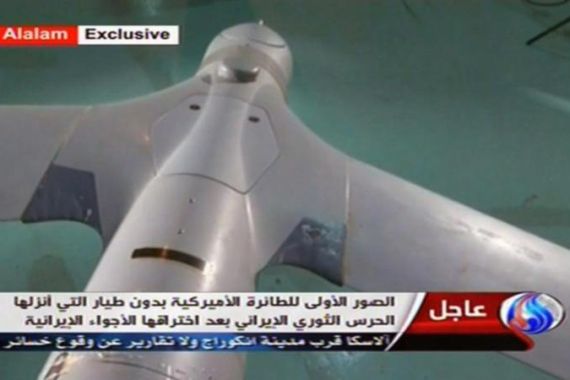Iran claims capture of US drone
Pilotless ScanEagle entered Iranian airspace over Gulf waters after taking off from warship, according to state media.

Iran has claimed to have captured a small US drone that penetrated its airspace over Gulf waters, but the US Navy in the region denied any of its unmanned spy planes were missing.
The naval arm of the Iranian Revolutionary Guards said in a statement on its website Sepahnews.com on Tuesday that “the unmanned US drone patrolling Persian Gulf waters, performing reconnaissance and gathering intel, was captured as soon as it entered Iranian airspace”.
The statement did not say how the aircraft was captured, nor where or when the incident took place. It said only that the drone had been conducting a mission over “the past few days”.
The Guards’ naval force, tasked with guarding Iranian assets in the Gulf, said the drone was a Boeing-made ScanEagle, a short-range, propellor-driven surveillance vehicle with a three-metre wingspan that is typically launched from ships and which can fly up to 100km.
Past precedents
Exactly a year ago, on December 4, Iran claimed to have captured a much bigger and more sophisticated CIA stealth drone, a bat-winged RQ-170 Sentinel.
Tehran rejected a US request for its return and said it would reverse-engineer that drone to make its own.
At the time, Iran claimed it had brought down the RQ-170 drone electronically, by “spoofing” its GPS guidance system. US officials contended the drone suffered a malfunction.
For the ScanEagle, no explanation was immediately advanced by the Iranians as to how they might have seized it.
Live Box 20124810121214994
A spokesman for US Fifth Fleet, Commander Jason Salata, told AFP news agency that none of the fleet’s drones was missing and that “nothing (has been) lost recently, in months”.
Salata also said all of the Fifth Fleet’s operations in the Gulf “are in compliance with international law,” implying that any flights conducted were outside of Iranian airspace.
Several countries apart from the United States use the relatively low-cost ScanEagle drones, including US allies the United Arab Emirates, Australia and Canada, all of which operate in the Gulf.
US forces in Iraq also used them before their withdrawal in October 2011.
Iranian State television networks Al-Alam and Press TV showed footage of what they said was the captured ScanEagle drone.
The light-grey, unmarked vehicle was shown suspended inside a hangar and apparently intact, with two Guards officers examining it in front of a poster saying, in English: “We shall trample on the US.”
A lawmaker who chairs the Iranian parliament’s defence commission, Esmaeel Kosari, boasted to Al-Alam of the drone’s capture and warned of “decisive confrontation” if Iranian airspace was violated again.
‘Airspace violation’
Foreign Minster Ali Akbar Salehi told state television Iran would protest the incident in international bodies.
“We had officially warned the Americans against violating our territory. Unfortunately they did not listen, and the Guards managed to catch the US drone,” Salehi said.
“The captured drone is proof to be used to follow up the American violation at international bodies,” Salehi said.
Iran’s foreign ministry said last week the US had violated Iranian airspace eight times in October, and warned of a “serious reaction” if such incursions continued.
On November 1, Iranian fighter jets fired on a US Predator drone in the Gulf but failed to bring it down, according to the US Defence Department.
Iran said the Predator had been on a reconnaissance mission near Bushehr, which hosts its only nuclear power plant, as well as its main oil terminal at Kharg island.
The most recent drone claim adds to military tensions between the two arch-foes in the Gulf.
Iran is subject to US surveillance, notably over its nuclear programme, which the West fears is being used to develop atomic weapons capability.
Iran denies its nuclear activities are anything but peaceful. It refuses to comply with repeated UN Security Council resolutions demanding it suspend uranium enrichment.